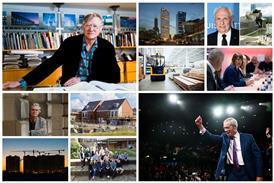Strolling around Whitehall and Horse Guards is a dispiriting urban experience with little typological variety, but that is not the point, writes Eleanor Jolliffe

Whitehall, The Mall, Horseguards Parade… they never make sense to me as a piece of city. Everything is a bit too big, a bit too closed, a bit too monumental. This whole section of central London is impressive, but somehow lacking in personality.
It also breaks all the rules – masterplanning and urban design rules, I mean. There is little typological variety (I certainly don’t recommend walking down Whitehall sightseeing with a four year old; there is nowhere for emergency bathroom access!).
Many of the buildings have raised ground floors, so you are met with blank stone walls at eye level, and there is nothing natural about the very armed surveillance along much of the route. Undoubtedly impressive, strolling around that area is nevertheless a dispiriting urban experience.
Watching the state funeral of Queen Elizabeth II, however – or any state event – this strange part of London made sense. This is not the permeable, walkable urbanism beloved of contemporary masterplanners; this is London as theatre.
It does not need to be a working piece of city – it is simply the face we turn to the world when something happens
The large facades act as the perfect foil to military parades and processions of royalty and the wide routes are so much better (as we all saw) than narrow country lanes for marching groups and parades of mounted cavalry.
The Portland stone acts as the perfect backdrop to the bright colours of our pomp and circumstance: the theatre of the British state in full flow is hard to be unmoved by.
This part of London is necessary for this show of state. It is successful urbanism simply by being such a truly dreadful day-to-day experience. It does not need to be a working piece of city – it is simply the face we turn to the world when something happens; the grandeur and solidity of it all lends weight and authority to what we are broadcasting.

I have friends who work along Whitehall. They all report that the insides of these buildings are crumbling, leaking, filled with mice. But these are perhaps the only office buildings in the country whose office function is secondary: first they are the public face of the British administration, second they are somewhere you could sit and work on a PowerPoint presentation.
>> Also read: The second Elizabethan age: eight decades in architecture
>> Also read: Charles was mostly right. It’s a shame we architects couldn’t see it
We are far from alone in using urbanism for nationalistic ends, and each country adds its own flavour: the wide boulevards of Paris are due to Napoleon’s frustration with the ease with which Parisians could barricade the narrow streets of the old city; North Korea, Germany, Taiwan and Finland are among those who have created inner city roads wide enough to be used as emergency military runways; and Israel and Palestine have all but weaponised urbanism in the way they have used land in the West Bank.
I could go on – almost every country has weaponised, utilised, fractured or manipulated their built fabric to propaganda or military ends.
Watching the funeral, it made me pause – not the impressiveness, the solemness of the moment or the sense of “history standing still”. I paused because here I could see Britain as it was designed – the vision of the state we portray to the world, and it made me think.
Humanity has, throughout history, built cities across the world in the image of who it wants to be. It maintains the illusions that work for that society, and rebuilds those that don’t.
Do we now genuinely care more for the daily lived experience of great cities than the face they turn to the rest of the world?
Cities and buildings are often targeted in war by military opponents in acts of cultural vandalism to undermine the image and ideology of the attacked nation. As if by destroying the cities – the image of a state – you can undermine its very existence.
However, how often do we truly consider this when working on masterplans? Over the years I have worked on several masterplans and the vision of the state, the nation or even the market town is rarely considered now. Instead consultants, planners and clients discuss the community access, the walkability, the permeability.
Security is considered in terms of high-impact bollards rather than sniper positions or military vehicle access. Do we now genuinely care more for the daily lived experience of great cities than the face they turn to the rest of the world?
Can it be true that governments and large organisations are finally moving past the theatres of war and peace that have driven so much of urban planning through history? And does that therefore mean that the world is slowly becoming a more tolerant, human place? Or are we just better at reframing these priorities in more human-sounding rhetoric?
















1 Readers' comment